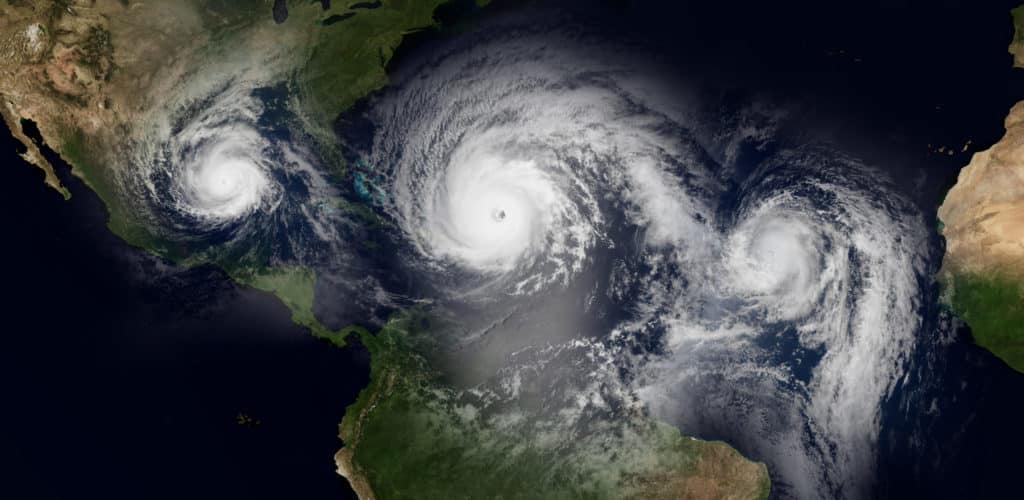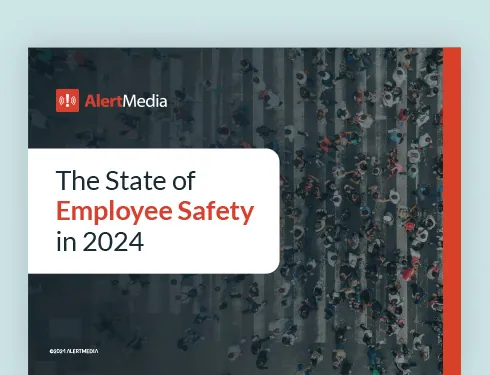
By the Hour: How to Brace Your Business Throughout a Hurricane
Learn how your business should message hurricane emergency communications through all phases of a hurricane: before, during, and after the storm.

At the dawn of the 20th century, Galveston was arguably slated to become the largest city in Texas. A 27-mile long island rising a mere five feet above sea level, the bustling town had grown into the state’s central port. Numerous millionaires called it home, and downtown’s Strand District was dubbed the “Wall Street of the South.”
All of that changed on September 8, 1900.
With little warning and a lack of the communication technology we now have, a Category 4 hurricane slammed into the coast. Winds in excess of 140 mph battered homes and businesses. A storm surge over 15 feet high swallowed the island. By the following morning, the entire city was leveled.
The hurricane ended up claiming the lives of an estimated 8,000 people and still stands as the deadliest natural disaster in U.S. history.
As a result of the devastation, Galveston never regained its former glory.
Fortunately, forecasting and emergency communications have come a long way since the primitive technology utilized in 1900. Experts are now able to detect and monitor a newly developed disturbance days in advance of its growth into a dangerous hurricane.
Communication Hurdles
That said, any emergency is likely to produce chaos and a breakdown in communication. Both Hurricanes Harvey and Katrina, because of their intensity and sudden catastrophic flooding, resulted in considerable loss of life.
Hurricane communication is also challenging because of the far-reaching impacts of a dangerous storm. Inland flooding, shipping route disruptions, and delays to traveling employees can all present obstacles. No matter how far from land a storm is, clear and early communication is the most effective way businesses can keep their people safe.
The following timeline, suggested by the Department of Homeland Security, provides specific messaging businesses should adopt throughout all phases of a hurricane.
Before the Storm
Hurricane preparation is crucial for any business regardless of a storm’s distance/time from shore. It’s important to fully understand the region you live in and how it might be susceptible to the impact of a major hurricane. Coastal areas are vulnerable to storm surge, but anywhere in the country can feel the ripple effects of a major storm.
Even before a hurricane has formed, leadership will want to brace employees and their organization for what impact could mean to business continuity. Establishing who in your organization is responsible for implementing your company’s emergency response plan and running through your hurricane preparedness checklist will help alleviate the stress when a hurricane does make landfall.
Emergency hurricane communications: Inform your people what the risks are of a major storm making impact. Consider running a drill to figure out proper evacuation protocol/routes in the event of a hurricane impacting your region (whether you’re on the coast or further inland). Instruct your people what to expect from leadership leading up to, during, and after a major storm moves through the area.
48 hours out
Defining terminology can help businesses brace for a potential hurricane. When a storm is forming and the initial forecast places a certain location in its path, a hurricane watch is issued. Understanding the difference between a hurricane watch and hurricane warning will help inform what actions your organization should take.
Hurricane Watch: Conditions are possible in the region within 48 hours.
Hurricane Warning: Conditions are expected in the region within 36 hours.
Whether a storm takes shape in the Atlantic, Gulf of Mexico, Caribbean, or the Pacific Ocean, businesses should still treat the situation as a potential emergency. Once winds reach tropical storm strength, preparation can be difficult (gathering supplies, preparing an office or residence, and communicating with all employees).
Emergency hurricane communications: Inform your people that a threat exists and is being closely monitored. Raise awareness that a storm has formed and could impact business operations. Let them know you’ll be providing further instruction as the situation develops and that they should defer to weather authorities regarding potential evacuations.
18–36 hours out
When a hurricane is roughly 24 hours from making landfall, every second counts. During this phase, leadership will want to pay close attention to the instruction provided by weather experts (evacuate or stay in place). If a hurricane warning has been issued, inform your people—they might not be aware of the latest updates. You’ll want to ensure that all company data is backed up on-premises, off-premises, and in the cloud.
You’ll also want to inform all employees to seek guidance from credible sources to avoid misinformation (as opposed to relying on social media). The National Weather Service will provide the most accurate storm updates and instructions.
Emergency hurricane communications: Inform your people that a dangerous hurricane is quickly approaching. During this phase, you should implement your emergency response plan where you’ll have assigned roles and responsibilities.
Key decision-makers will need to be contacted and instructed to follow whatever tasks they’ve been assigned as part of your company’s emergency response plan.
6–18 hours out
During this phase, you should have a clearer sense of whether or not your organization will need to close. Leadership should be able to quickly coordinate with key decision-makers throughout a storm. Some emergency communication providers offer a conference call feature that allows for immediate connection to ensure everyone is on the same page.
Having a reliable emergency notification system in place is essential to early and actionable messaging that helps keep your people safe and your business protected.
Emergency hurricane communications: Messaging during this phase is critical. You should be able to inform employees whether or not the office will remain open. Let them know you’ll keep them informed with developing updates.
6 hours out
When a storm is within hours of making landfall, employees should be in the final stages of preparation. If they haven’t evacuated, they should be stocked up on water and supplies and monitoring current weather reports (every 30 minutes to stay up to date).
In terms of hurricane preparedness for your business, you should have data backed up and have locked down ways to maintain and restore operations. These include equipping your workplace with an uninterruptible power supply: batteries/generators for power outages and gasoline-powered pumps to keep lower levels of the structure from flooding.
Emergency hurricane communications: Instruct employees to follow the guidance of weather specialists. They should stay indoors and away from windows—shattered glass and flying debris could be deadly.
You’ll also want to instruct your people to keep their mobile devices fully charged during this phase (to prepare for possible power outages). They’ll need to stay connected in order to receive relevant emergency communications, reply to status check-ins, and stay informed of office closure/reopening announcements.
During the Storm
Safety is the top priority as a dangerous hurricane moves through your region. If an evacuation has been ordered and employees haven’t been able to make it out, let them know where safe shelters are located (FEMA safe rooms or locally designated safe facilities such as schools).
Businesses should be on lockdown until the storm has passed and weather officials have given the all-clear. During this time, it’s important to monitor the condition of the storm and relate vital information to your people.
Some emergency communication providers offer two-way communication and wellness checks. Send out a quick survey during this period to check in on your people and determine if they’re in need of immediate assistance.
Emergency hurricane communications: Be explicit. Inform staff that there is an immediate danger if they leave their homes. Let them know they should brace for an extended office closure and that your organization will keep them informed.
After the Storm
An organization’s main priorities immediately following a storm: assessing the damage and restoring business continuity as quickly as possible. You’ll also want to help your community recover, which can indirectly impact your organization’s ability to bounce back. Damage assessment should involve documentation with photos and video for insurance claims.
This period will likely be a chaotic time, so it’s important to provide your people with as much information as possible. A central hub or “Event Page,” is where a company can share valuable resources, post-hurricane relief updates, upload videos/photos and communicate a recovery plan.
Emergency hurricane communications: Keeping your people informed immediately following a hurricane is just as important as messaging before and during a major storm. Direct them to your organization’s Event Page and send out wellness check surveys. You’ll also want to communicate when the office will reopen and what the alternate working plan will be until operations have been restored.
As a hurricane approaches, you won’t have a minute to spare. Having messaging in place will alleviate stress and ultimately help protect your people. AlertMedia, the leader in emergency communication software provides hurricane templates that give businesses pre-set messaging throughout all phases of a storm.
Keep Your People Aware
Thanks to two-way communications, an intuitive user interface, and 24/7 customer support, AlertMedia helps your organization rest easy knowing you’re prepared if a storm is heading your way.



![6 Steps to Creating an Effective Emergency Response Plan [+ Template]](https://www.alertmedia.com/wp-content/uploads/2023/10/Blog-Emergency-Response-Plan.webp)
